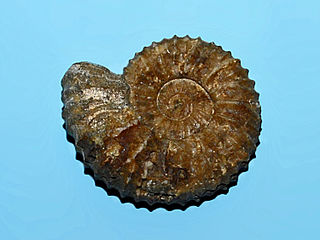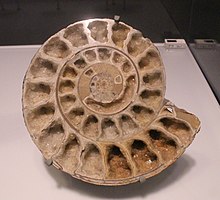
Audaxlytoceras is an extinct genus of lytoceratid ammonites.
Bifericeras is a Lower Jurassic ammonite belonging to the family Eoderoceratidae, and sometimes placed in the subfamily Xipherceratinae. Whorls are strongly depressed, but still evolute in coiling. The early growth state is prolonged, and smooth, followed by a late growth stage with rounded, straight, bituberculate ribs.

Pavlovia is an extinct genus of ammonite of the Late Jurassic to Late Cretaceous.
Eudmetoceras is an extinct genus from a well-known class of fossil cephalopods, the ammonites. It lived during the Jurassic Period, which lasted from 171.6 to 168.4 million years ago.
Procerites is an extinct genus from a well-known class of fossil cephalopods, the ammonites. It lived during the Jurassic Period.

Nannolytoceras is an extinct genus of lytoceratid ammonite, family Lytoceratidae, with a stratigraphic range extending from the Bajocian age to Bathonian age.

Leptosphinctes is an extinct genus from a well-known class of fossil cephalopods, the ammonites. It lived during the Jurassic Period, which lasted from approximately 200 to 145 million years ago.
Kumatostephanus is an extinct genus from a well-known class of fossil cephalopods, the ammonites. It lived during the Jurassic Period, which lasted from approximately 200 to 145 million years ago. It was slow moving and likely to fall victim to large predators such as Liopleurodon, or small mosasaurs.
Kosmermoceras is an extinct genus from a well-known class of fossil cephalopods, the ammonites. It lived during the Jurassic Period, which lasted from approximately 200 to 145 million years ago.

Hyperlioceras is an extinct genus of cephalopod included in the ammonitid family Graphoceratidae that lived during the Bajocian stage of the Middle Jurassic. The type species is Hyperlioceras discites
Hlawiceras is an extinct genus from a well known subclass of fossil cephalopods known informally as ammonites that lived during the Jurassic Period, which lasted from approximately 200 to 145 million years ago.

Psiloceras is an extinct genus of ammonite. Psiloceras is among the earliest known Jurassic ammonites, and the appearance of the earliest Psiloceras species form the definition for the base of the Jurassic. Unlike most earlier ammonites, which had complex shell shapes and ornamentation, Psiloceras had a smooth shell.

Phylloceras is an extinct genus of ammonoid cephalopods belonging to the family Phylloceratidae. These nektonic carnivores lived from Early Jurassic to Late Cretaceous.

Macroscaphites is an extinct cephalopod genus included in the Ammonoidea that lived during the Barremian and Aptian stages of the Early Cretaceous. Its fossils have been found throughout most of Europe and North Africa.

Lytoceras is an ammonite genus that was extant during most of the Jurassic and Cretaceous periods, and is the type genus for the family Lytoceratidae. These cephalopods were fast-moving nektonic carnivores.

Pseudowaagenia is a genus of extinct ammonoid cephalopods in the family Aspidoceratidae.

Harpoceras is an extinct genus of ammonite belonging to the family Hildoceratidae. These cephalopods existed in the Jurassic period, during the Toarcian age from the Falciferum zone to the Commune subzone of the Bifrons zone. They were fast-moving nektonic carnivores.

Reineckeia is an extinct genus of ammonoid cephalopods belonging to the family Reineckeiidae.

Euaspidoceras babeanum is an extinct ammonoid-cephalopod species that lived during the Jurassic period.

Euaspidoceras perarmatum is an extinct ammonoid cephalopod species that lived during the Jurassic.














